Michigan Spiders. Can They Kill You?
There are about 4,000 species of spiders in the United States. Of those thousands of species, most of them produce venom. However, not all of these venomous spiders pose a threat to humans. The good news for us Michiganders? According to the Michigan Department of Natural Resources, there are only two species of poisonous spiders in Michigan. Despite that fact, there still seems to be a common fear of these eight legged creepy crawlers and most are not welcomed in our homes and offices. This article will help you get familiar with the most common spiders in West Michigan, what they eat, where they live, common spider myths, and how to spider-proof your home.
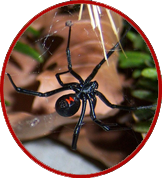 Northern Black Widow Spider (Latrodectus Variolus) – Poisonous
Northern Black Widow Spider (Latrodectus Variolus) – Poisonous
The Northern Black Widow Spider is most common in the Middle Atlantic States. In Michigan, it’s most commonly found in the lower western peninsula. They are uniformly black and small, measuring only about a ½ inch long. The females will have the classic and ominous red hourglass shape on their abdomen while the males will lack the hourglass shape, but still have a red or yellow black band on their abdomen or back. Only the bite of the female is harmful to humans.
Where they live: Outdoors they typically reside in old stumps, hollow logs, woodpiles and leaf piles. Indoors they build webs in the corners of garages, crawlspaces, sheds and other dark dwellings.
What they eat: Like most spiders, the black widow captures ants, caterpillars, grasshoppers, cockroaches, and other small arthropods in their webs. They can also go months without eating.
Common myth: Black Widows are aggressive and often deadly. Even though black widows are considered one of the most dangerous venomous species, their bites are infrequent due to the extremely shy nature of the spider. The venom of a black widow is 15 times more toxic than a rattlesnake, but has a less than 1% mortality rate among victims.
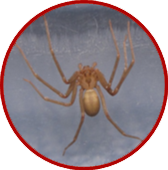
Brown Recluse (Loxosceles reclusa) – Poisonous
The Brown Recluse, or sometimes known as the Violin Spider because of their violin-shaped mark on their back, isn’t actually native to Michigan but does occasionally turn up in the state. It’s most common in the southern United States such as Kansas, Oklahoma, Arkansas, Alabama and surrounding dry areas. Still relatively small, an adult brown recluse measures about 6 to 11 cm long and are roughly the size of a United States quarter. Similar to the black widow, the spider is shy in nature and rarely bites unless threatened.
Where they live: They often hide in dark, secluded places and love to reside in man-made areas such as garages, trash cans, tires and attics.
What they eat: Like many other spiders, it can go months without eating, but they prefer to eat cockroaches, crickets, flies and any other insects that get caught in the web. In addition to capturing prey in a web, brown recluse will also go out and hunt.
Common myth: As mentioned before, they are not native to Michigan, but do have the ability to find their way here. Brown recluse are known for being avid travelers and often hitch a ride from southern states via trucks, cars and packages.
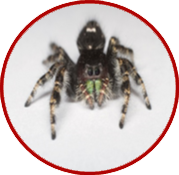 Jumping Spider (Salticidae) – Not Poisonous
Jumping Spider (Salticidae) – Not Poisonous
With over 300 species in just North America, the jumping spider is one of the largest and most common spider species in North America. They are known for their superior eyesight and ability to jump as high as 25 times their own length. Jumping Spiders are often recognized by their eye pattern and hairy body. Colors can vary for the spider, and often are the same tone as the habitat they live in, but most of them have an earthy and brown color.
Where they live: Most species are generally found in grassland, woodland, gardens and prairie environments. They do also tend to wander into homes, barns and other residential structures.
What they eat: They prey on bollworms, webworms, stinkbugs, mosquitos, a wide range of arthropods and also eat nectar.
Common myth: Not so much a myth, but part of what makes the Jumping spider a great hunter is that they can see in other spectrums of light such as UVA and UVB and have trichromatic vision. That means they have true color vision, just like humans.
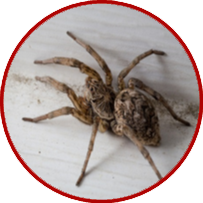 Wolf Spider (Lycosidae) – Mildly Poisonous
Wolf Spider (Lycosidae) – Mildly Poisonous
The Wolf Spider is a wide family of spiders most of them large, dark and active. Unlike most spiders, Wolf Spiders don’t catch their prey in webs, but instead hunt them down with their powerful eyesight and fangs. Size will vary among location but most are between 6.4 mm to 3cm long. They are typically brown, gray, black or tan and their coloring acts as camouflage in their environment. Wolf Spiders also are distinct because of the presence of hair on their legs and body.
Where they live: This spider is a ground dweller and tends to have burrows and retreat instead of a traditional web like other spiders. Most of the species are wanderers and don’t have permanent homes and therefore can be found in habitats such as woodland, shrublands, gardens and homes.
What they eat: They eat mostly ground dwelling insects as well as other spiders. Hunting methods differ by species, some will chase down their prey while others wait for it to pass by and ambush it. With either method, these spiders are known for being speedy, agile and well sighted hunters.
Common myth: A wolf spider is not poisonous to humans. This is false; a bite from a wolf spider does have enough toxicity to cause some adverse health effects to a human, and should be given medical attention, but is not lethal if left unattended.
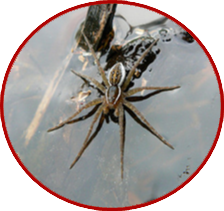 Fishing Spiders (Dolomedes) – Not Poisonous
Fishing Spiders (Dolomedes) – Not Poisonous
Often described as a larger wolf spider, the fishing spider is a semi-aquatic hunting spider. These spiders are covered in short, slick hair that allow them to use surface tension to run or stand on the water. The females can be as large as 2 ½ inches long in length while the males are slightly smaller with each of them having a brown/grayish color with black and brown markings.
Where they live: They’re mostly found in wooded settings under stones, bark, tree stumps and man-made structures close to a water source.
What they eat: Similar to the wolf spider, fishing spiders do not use a web to catch their prey; they are hunters and willing to travel pretty far to find the right meal. When hungry they take to the water in search of aquatic insects, tadpoles, frogs and small fish.
Common Myth: Fishing spiders can only float on the water. The Fishing spider can actually swim under water and stay submerged for several minutes. It can do so by using the air bubbles it traps in the fine hairs under its belly.
Benefits of Spiders
Despite popular belief, there is more to spiders than just scaring humans. Spiders are extremely useful to our gardens, homes and ecosystem. The top benefit: they’re nature’s pest control. Spiders aid in controlling other household pests like mosquitoes, cockroaches, grasshoppers and flies. All of these insects have been known to devastate crops, gardens and homes and chemical control can only do so much. So bottom line: they don’t eat, we don’t eat. Through limiting the population of these pests, spiders can also assist in significantly decreasing the onset of several diseases. An example being that spiders contribute to lessening the spread of malaria from mosquitoes and typhoid from house flies. In addition to being crop protectors and disease defectors, spiders’ venom is currently being studied by scientists as it may help to treat arthritis. Medical applications that involve the uses of spider silk and spider venom are increasing in number. So next time you and a creepy crawler come face to face, try to refrain from squashing (and crying) and release them back outside or walk around it instead.
How to Spider-Proof Your Home& Tips for Spider Control
Most spiders don’t attempt to enter houses unless there is an extreme change in weather. Periods of heavy rain or drought will drive spiders indoors, as will cold temperature. This time of year is when people see an increase in unwanted house guests. So what can you do without clouding your home in chemicals? There are several eco-friendly, cost-effective and basic steps to prevent spider entry. First and foremost, make sure your home doesn’t have any apparent gaps or openings. Where there’s a gap, there’s a way. You can install door sweeps on your exterior doors and use caulk to seal the outside edges of your doors, widow, and outdoor faucets to seal any remaining gaps. If you have any crawl space or attic openings, be sure to cover those with wire mesh. Not only does it prevent spider entry, but debris and larger critters as well. Trimming shrubs and ornamental trees around your house foundation can also help. It is also wise to avoid stacking firewood against the home as spiders love to build webs and nests in them. Lastly, while this might seem like common sense to some people, having a clean and tidy home will discourage web builders. Vacuuming, keeping food sealed and put away and regularly cleaning basements and attics can go a long way in preventing spider entry.
Image credits:
